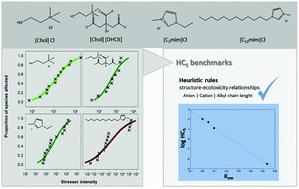当前位置:
X-MOL 学术
›
Green Chem.
›
论文详情
Our official English website, www.x-mol.net, welcomes your feedback! (Note: you will need to create a separate account there.)
Applicability of heuristic rules defining structure–ecotoxicity relationships of ionic liquids: an integrative assessment using species sensitivity distributions (SSD)
Green Chemistry ( IF 9.8 ) Pub Date : 2020-08-28 , DOI: 10.1039/d0gc02486d Beatriz Mano 1, 2, 3 , Fátima Jesus 1, 2, 2, 3, 4 , Fernando J. M. Gonçalves 1, 2, 2, 3, 4 , Sónia P. M. Ventura 2, 3, 5, 6 , Joana Luísa Pereira 1, 2, 2, 3, 4
Green Chemistry ( IF 9.8 ) Pub Date : 2020-08-28 , DOI: 10.1039/d0gc02486d Beatriz Mano 1, 2, 3 , Fátima Jesus 1, 2, 2, 3, 4 , Fernando J. M. Gonçalves 1, 2, 2, 3, 4 , Sónia P. M. Ventura 2, 3, 5, 6 , Joana Luísa Pereira 1, 2, 2, 3, 4
Affiliation

|
The toxicity of Ionic Liquids (ILs) to aquatic organisms has been a matter of substantial interest, involving the toxicity assessment for a small number of species, which is limitative given the variation in species sensitivity to different classes of ILs. Therefore, the main objective of this study was to validate, using an integrative approach (i.e., integrating the responses of several species), the heuristic rules that have been assumed for the ecotoxicity of ILs, namely the effects of the cation, elongation of the cation alkyl chain and anion moiety. For this purpose, four ILs were selected as models and their toxicity was determined for a wide variety of species, which allowed the development of species sensitivity distribution curves. The analysis of the distribution curves enables the determination of hazard concentrations affecting 5% of the represented communities (HC5) and also the establishment of structure–ecotoxicity relationships for ILs. The median effect concentration (EC50) values varied widely and the species most sensitive to each IL was variable. The integrative HC5 values varied by five orders of magnitude, between 3.020 × 10−3 mg L−1 representing the 1-dodecyl-3-metilimidazolium chloride, which raises concerns on the environmental hazardous potential of this IL, and 106.9 mg L−1 for cholinium chloride, which confirms its low environmental toxicity. The SSD approach showed cholinium chloride as the least toxic IL, followed by cholinium dihydrogenocitrate, 1-ethyl-3-methylimidazolium and 1-dodecyl-3-methylimidazolium chloride, as the most toxic. This illustrates the minor effect of the anion on toxicity for this set of ILs, whereas the cation and the cation alkyl chain length had pronounced effects, validating the heuristic rules defining structure–ecotoxicity relationships of ILs. A very strong linear correlation between hydrophobicity and HC5 was found (ρ = −0.9991). This approach allows a more efficient prediction of the potential environmental effects of ILs, thus preventing the need to comprehensively assess to the ecotoxicity of all ILs, which can be many within each family and each cation/anion possible combination. Ultimately, this will sustain the development of ILs posing less environmental hazards nonetheless retaining the desired performance.
中文翻译:

定义离子液体的结构与生态毒性关系的启发式规则的适用性:使用物种敏感度分布(SSD)的综合评估
离子液体(ILs)对水生生物的毒性一直是引起人们广泛关注的问题,涉及对少数物种的毒性评估,鉴于物种对不同类别的ILs的敏感性差异,这种评估是有局限性的。因此,本研究的主要目标是使用综合方法进行验证(即,整合了几种物质的响应),为IL的生态毒性假设了启发式规则,即阳离子的作用,阳离子烷基链的伸长和阴离子部分。为此,选择了四个IL作为模型,并确定了它们对多种物种的毒性,从而可以绘制物种敏感性分布曲线。分布曲线的分析可以确定影响5%代表性社区的危害浓度(HC 5),并可以建立IL的结构-生态毒性关系。中值作用浓度(EC 50)值变化很大,并且对每个IL最敏感的物种是可变的。集成式HC 5值变化了五个数量级,介于3.020×10 -3 mg L -1之间,代表1-十二烷基-3-metamimidazolium氯化物,这引起了对该IL的环境危害的关注,而其值则为106.9 mg L -1用于氯化胆碱,证实了其低环境毒性。SSD方法显示氯化胆碱是毒性最低的IL,其次是毒性最高的二氢氯化胆碱,1-乙基-3-甲基咪唑鎓和1-十二烷基-3-甲基咪唑鎓氯化物。这说明了阴离子对这组ILs的毒性影响较小,而阳离子和阳离子烷基链长度具有明显的影响,从而验证了定义ILs结构与生态毒性关系的启发式规则。发现疏水性与HC 5之间存在非常强的线性关系(ρ= -0.9991)。这种方法可以更有效地预测IL的潜在环境影响,从而避免了对所有IL的生态毒性进行全面评估的需要,在每个家族中,每种IL和可能的阳离子/阴离子组合中可能有很多。最终,这将维持IL的发展,而IL却对环境的危害较小,但仍保持所需的性能。
更新日期:2020-09-21
中文翻译:

定义离子液体的结构与生态毒性关系的启发式规则的适用性:使用物种敏感度分布(SSD)的综合评估
离子液体(ILs)对水生生物的毒性一直是引起人们广泛关注的问题,涉及对少数物种的毒性评估,鉴于物种对不同类别的ILs的敏感性差异,这种评估是有局限性的。因此,本研究的主要目标是使用综合方法进行验证(即,整合了几种物质的响应),为IL的生态毒性假设了启发式规则,即阳离子的作用,阳离子烷基链的伸长和阴离子部分。为此,选择了四个IL作为模型,并确定了它们对多种物种的毒性,从而可以绘制物种敏感性分布曲线。分布曲线的分析可以确定影响5%代表性社区的危害浓度(HC 5),并可以建立IL的结构-生态毒性关系。中值作用浓度(EC 50)值变化很大,并且对每个IL最敏感的物种是可变的。集成式HC 5值变化了五个数量级,介于3.020×10 -3 mg L -1之间,代表1-十二烷基-3-metamimidazolium氯化物,这引起了对该IL的环境危害的关注,而其值则为106.9 mg L -1用于氯化胆碱,证实了其低环境毒性。SSD方法显示氯化胆碱是毒性最低的IL,其次是毒性最高的二氢氯化胆碱,1-乙基-3-甲基咪唑鎓和1-十二烷基-3-甲基咪唑鎓氯化物。这说明了阴离子对这组ILs的毒性影响较小,而阳离子和阳离子烷基链长度具有明显的影响,从而验证了定义ILs结构与生态毒性关系的启发式规则。发现疏水性与HC 5之间存在非常强的线性关系(ρ= -0.9991)。这种方法可以更有效地预测IL的潜在环境影响,从而避免了对所有IL的生态毒性进行全面评估的需要,在每个家族中,每种IL和可能的阳离子/阴离子组合中可能有很多。最终,这将维持IL的发展,而IL却对环境的危害较小,但仍保持所需的性能。


























 京公网安备 11010802027423号
京公网安备 11010802027423号